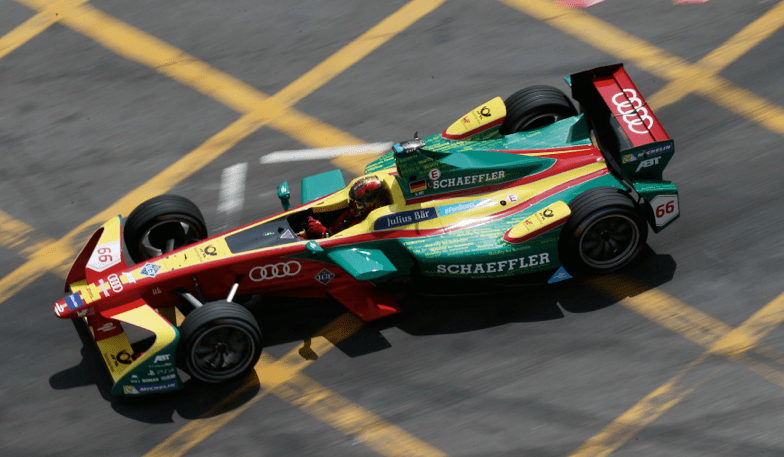
Formula E is now an integral part of motorsport. This worldwide series of races for electric vehicles now attracts more automotive manufacturers and suppliers than any other racing series. Schaeffler is one of the early pioneers of the sport and, as an exclusive technology partner, is developing the powertrain in conjunction with the ABT Schaeffler Audi Sport team.
The supplier also uses Formula E to prove its developments in the field of electric drive technology for volume production: “Our participation in Formula E helps us to achieve a better understanding of the environment and systems involved in electric mobility,” says Prof Peter Gutzmer, deputy CEO and chief technology officer at Schaeffler. Meanwhile, the engineers are using the expertise gained from racing in both current systems such as hybrid modules and electric drive axles, and for tomorrow's technology.
Formula E has become a test track for developing future automotive drive technologies. The first Formula E race of 2017 is still in the future, but at CES, it will happen in virtual reality on driving simulators. The regular Formula E drivers will compete at the Las Vegas Venetian Hotel against virtual reality specialists who have qualified for the Race to Vegas spectacular.
The teams take this virtual competition extremely seriously. “The tracks are reproduced in a virtual environment before every race and are driven by the drivers on a simulator,” said Dr Simon Opel, director special projects motorsports at Schaeffler. “The most important thing for us is to find the right race strategy for the team, the driver and the vehicle.” Regular training sessions on the simulator are invaluable for finding the most successful compromise between performance and efficiency.
Since the 2015/2016 season FIA regulations have allowed teams to develop their own powertrain. The interplay between the electric motor, including the power electronics and the transmission, and the chassis are vital for success in the races and both software and the driver have a significant role to play in this. “With a fixed ratio, we would need a high torque, relatively heavy motor,” said Dr Opel. “We have therefore decided to go with three gears – the motor is lighter and this gives the driver more direct control over the motor speed.” The challenge for the drivers Lucas di Grassi and Daniel Abt includes finding the right sailing and recuperation phases. This is particularly the case with braking, where timing is everything, as the braking energy is returned to the battery by the electric motor and the mechanical braking is also delayed.
Whether it is understanding the system, cooling the motor, developing new materials or recuperation (gaining energy from braking), the expertise moves directly from the race track to the development engineers. Schaeffler has doubled its team of component developers for electric vehicles in a short space of time and is focusing heavily on new solutions for electrification of the powertrain in volume-produced vehicles.
A typical example is the economical launch pad into the world of electric drives provided by the 48V hybrid module, which is designed in a so-called P2 arrangement between the internal combustion engine and the transmission. This allows vehicles to move off using electric power only, to maintain the speeds required in city traffic purely electrically and to capture braking energy. This means they already offer significant potential reductions in CO2 and at minimal cost.
Powerful, high-voltage drive concepts provide longer stretches of purely electric driving. The P2 high-voltage hybrid module from Schaeffler, with its wide torque range, offers a great deal of potential in terms of reducing consumption and emissions from road vehicles. This will go into production in 2017.
Electric axles are another type of drive. Here, the electric motor provides traction to whichever axle is not driven by the internal combustion engine. An electric axle therefore allows hybrid vehicles to have all-wheel drive and can also be used for vehicles with purely electric drive i.e. without an internal combustion engine.
The wheel hub drive for purely electric drives is a further highlight in Schaeffler’s product portfolio. The so-called E-Wheel Drive shows how the supplier has been able to incorporate the drive technology into the wheels of the vehicle. It is a vital component for new vehicle concepts such as small buses or taxis in urban areas of towns and cities. In wheel hub drives, all the necessary components such as the electric motor, the power electronics, brakes and cooling are located within the wheel rim. This saves space and leaves room for future ideas and concepts. Other advantages are optimum maneuverability, easy parking and absolute eco-friendliness for tomorrow's mobility. “We have taken the predevelopment of the E-Wheel Drive to the point where we can now start to incorporate it into real-life projects,” said Sebastian Wielgos, who leads the E-Wheel Drive development programme at Schaeffler.










National Gas receives funding to develop Gravitricity underground hydrogen storage system
One single rock salt mine - Winsford - has 23 <i>MILLION </i>cubic metres of void and even allowing for 10% of that void set aside for hazardous waste...